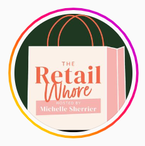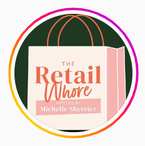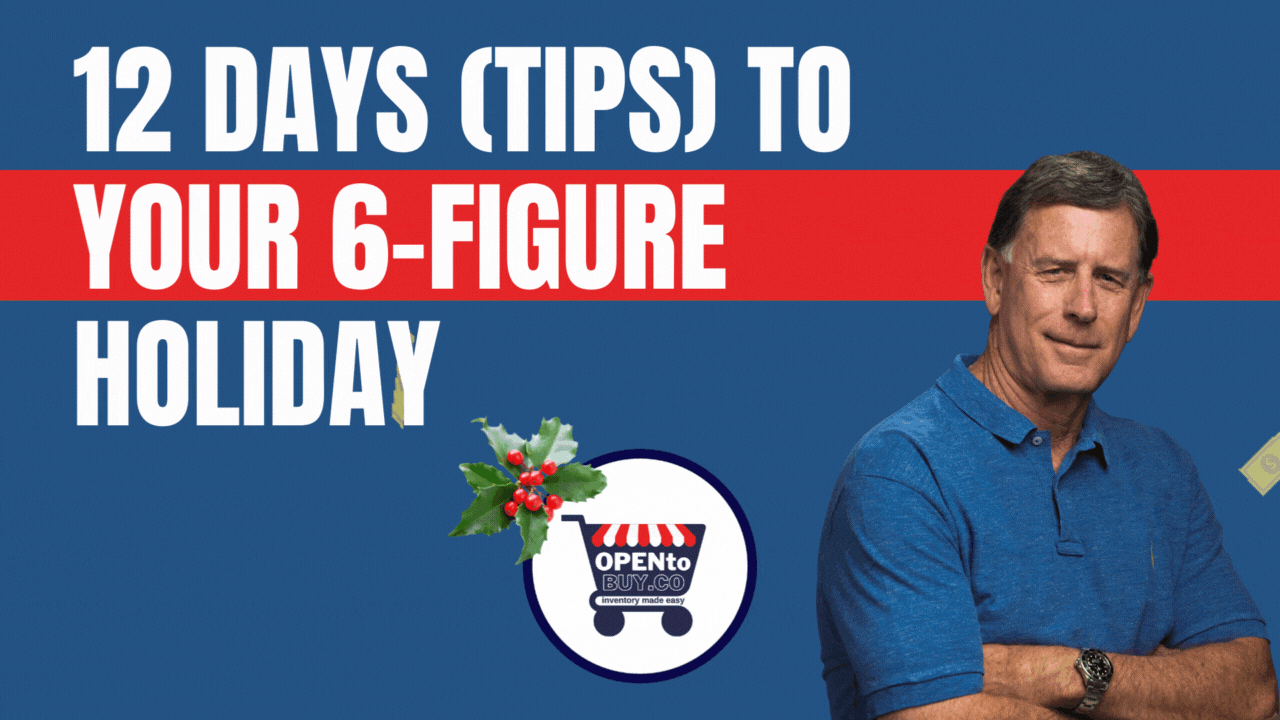|
0 Comments
Want to know the "Secret Sauce" to spending $100,000's on inventory for your business each year and increasing profitability with eliminating "stale" merchandise that just sits there and in some cases, you can't even give away. Look no further, our Co-Founder, Larry Hebert lays it all out in the blog below!
Before you start in, be sure to get Larry's gems and gold nuggets of financial wisdom in your inbox:
But first, a special plug for our favorite podcast, The Retail Whore! Live and breathe retail, then this is a must watch/listen podcast. We love Michelle and her program so much, we're an official sponsor, CHECK IT OUT!
Creating an OpenToBuy for your retail business consists of two areas to be successful. First, establishing your base inventory, highlighting each month with how much is available to spend, assures you have ample inventory to meet your projected sales. This is a formula developed through projected and actual sales, COGS, annual inventory turns and and beginning inventory each month. The second critical step in the OpenToBuy process is managing your Key Product Categories to ensure you have invested your inventory dollars properly based on each category's % of overall sales. Not managing this area will cause you to have too much inventory in some areas and too little in others. And both cause the same issue, lower cash flow and profitability. Having too much inventory will mean product is on the shelves not selling which ties up cash and forces you to lower the price to eliminate goods. And too little will mean you are missing sales when product is "sold out" causing cash flow and profitability to decrease. The goal (the "secret sauce") is to closely manage the Key Product Categories that generate 75%-90% or more of your business. This generally is between 6-8 categories with everything else being miscellaneous. You DO NOT want to manage every category but only those responsible for generating 75% to 90% or more of your business. How are Key Product Category % arrived at? 1) Use your POS system as the tool to obtain these numbers. 2) Take data from the last 12 months, separate into the top category sellers by total sales for each one and divide each into the total sales for that period. 3) These will provide you with the % that the Product Category represents of overall sales. And purchasing inventory in this % (how to use the "secret sauce") will ensure you have ample inventory based on customer sales (feedback) to meet demand resulting in greater cash flow and greater profitability. The Key Product Category amount is the % times the total Cost of Goods Sold for the 12-month period of your open-to-buy. Example
When you do this for your Key Product Categories generating 75%-90% or more of your overall business, you will have a specific dollar amount to spend for the year in each category equaling the annual COGS amount of $500,000 with all categories including Miscellaneous equaling 100%. It's recommended to check your POS system quarterly and verify these Key Product Categories % have not changed significantly based on actual sales. If their % of overall sales for categories have adjusted, change those categories to align with your current sales data. This will adjust each category's open-to-buy to better correspond with sales and allow for the proper amount to be purchased to ensure your sales goals are met. Make sure all categories after an adjustment continue to equal 100%. Doing this can and will transform your inventory purchasing, increase cash flow and enhance your profitability. OpenToBuy.co is designed to create the two critical pieces necessary to develop and manage your inventory purchases. A proprietary formula is embedded in the template to automatically calculate the base inventory and determine how much to spend each month, cumulative for each subsequent month and for the year on merchandise. It also includes Key Product Category management based on the top 6-8 categories generating 75%-85% and more of the total revenue to ensure you have the correct amount of goods in the proper categories to maximize your inventory investment. Using OpenToBuy.co WILL increase your cash flow and profitability by not under or overbuying and ensuring your cash is in the right products based on customer demand.
If you enjoyed these tips, be sure to sign up for Larry's finance made easy eblasts that are loaded with all sorts of advice to get you on top of your numbers and overall cash flow growing.
As you transition from the fall/winter season to spring/summer here are three tips to maximize your ability to generate revenue, maintain margins and reduce unsold merchandise on the shelves.
Before you start in, be sure to get Larry's gems and gold nuggets of financial wisdom in your inbox:
1. HAVE AN OPEN-TO-BUY (OTB) IN PLACE
Product-based businesses selling merchandise to generate their revenue spend between 50%-70% of every dollar generated on inventory. Developing an OpenToBuy purchasing plan by creating a base inventory will provide a monthly budget for you to purchase goods and ensure you don't overbuy or underbuy which causes the same issue: Reduced cash flow and lower profits. The base inventory is determined by the projected sales, cost of goods sold % and annual inventory turns for the store and are integral to being a successful retailer. If you're able to follow the plan you will have less unsold goods on the shelves, increase your cash flow and generate higher profits. 2. MANAGING KEY PRODUCT CATEGORIES An essential part of the OTB plan is to identify and manage your key product categories generating the MOST revenue. This is based on the % of sales from each category of the overall sales and related Cost of Goods Sold (COGS) related to these sales. Creating an OpenToBuy for each category will ensure you maximize your inventory investment by having the proper amount in each area based on their % of overall sales. Traditionally, 6-8 product categories generate 75%-85% or more of a store's revenue and are the areas needing to be managed. Everything else is Miscellaneous. You DO NOT need to follow every category in the store but only the one's totalling 75%-85% of the sales. When you are able to do this you will increase sales revenue by having ample product in key product categories and reduce non-selling inventory, thus increasing gross profit margins and cash flow by having less to place on sale to move. 3. MOVE SEASONAL & NON-SELLING MERCHANDISE As you come to the end of one season and enter the next, it's important to begin the process of moving these goods by placing them on sale to encourage customers to purchase and get off your shelves. This is done by reducing the price to entice customers to buy and ensure you do not have "old" merchandise as you enter a new season. Keeping "old" goods reduces your OpenToBuy purchasing power since it's dependent on a base inventory level that will be higher if product is not moved and allows you to purchase less "new" inventory for the upcoming season. Lastly, selling products at a lower price allows you to use the funds for new goods that you will be able to sell at the full retail price, thus increasing your cash flow and profitability.
If you enjoyed these tips, be sure to sign up for Larry's finance made easy eblasts that are loaded with all sorts of advice to get you on top of your numbers and overall cash flow growing.
To be a successful business owner you need to be involved with the financial planning for 2023 and review of 2022 to better understand the trajectory of your business, how you performed vs 2022’s plan and make informed decisions for 2023. Below are ten recommendations as you begin 2023 and plan for a successful year. Our Co-Founder, Larry Hebert has assembled the best of the best in terms of advice to get that cash register ringing, owners' draws increasing and your overall cash flow to have a STELLAR 2023! Before you start in, be sure to get Larry's gems and gold nuggets of financial wisdom in your inbox: And a special plug for our favorite podcast, The Retail Whore! Live and breathe retail, then this is a must watch/listen podcast. We love Michelle and her program so much, we're an official sponsor, CHECK IT OUT! Meet with your accountant - Review 2022 results before you begin the financial planning process for 2023. See the results of the operation: revenue, cost of goods, gross profit margin, operating expenses and net income. These will be a key component in planning your 2023 forecast. 2023 cash flow and P/L forecast – based on your 2022 results and new strategies you have developed, create a path for success in 2023. Enter in your anticipated revenue, operating expenses and all non-operating expense cash expenditures (draws, loan principal payments, capital investments, etc., along with additional cash infusions other than operations (loans, personal funds, investors). Look at the projected profitability and ending cash 12/31/23. Make any changes needed and once you arrive at your goal create a strategy to execute the financial plan. Make financial goals for 2023 – identify clear financial goals you want to accomplish (profitability, ending cash, Gross Profit Margin %, etc.). Create an OpenToBuy (OTB) Purchasing Plan – Product based businesses on an annual basis spend between 50%-70%+ on inventory. Developing an OTB plan by creating a base inventory and specifying the annual turns will provide a pathway to success for product-based companies. The OTB will specify how much inventory can be purchased each month and monitor it all so retail businesses do not over or underbuy which impact both cash flow and profitability. Key Product Category Management – An essential part of the OTB plan to ensure investment in inventory is maximized, is allocating dollars to the top Product Categories based on their % of overall sales. When this is done cash flow and profitability increases as you will not over or underbuy in your key categories. Based on client analysis 6-8 Product Categories generate 75%-90% of the business’s revenue. When these are managed properly the business has a better annual inventory rate and less “bad” inventory on the shelves. Determine 2022 Annual Inventory Turns – This is a critical metric for a retail business. The better the annual turn the less inventory you need on the shelves to meet your projected revenue goals. The is determined by taking inventory totals on the 1st day of a month for 4, 6 or 12 months, add these inventory figures together and divide by the number you used. Then divide this average inventory number into the Cost of Goods Sold for the 2022 and you will obtain your Inventory Turn Rate. Although there are industry exceptions (jewelry stores average turn is 1.6 annually) the average retail store should turn their inventory 3-4 times per year with 4, or every 90 days, being ideal. If you turn significantly more than 4, you’re missing sales and you can’t replace the goods quickly enough. If you turn less than 3 you have too much inventory that is not “moving”. Both turning too quickly or not enough result in the same issue, lower cash and less profitability. Move Seasonal and Non-Moving Product – It’s essential to move seasonal and non- moving product in January and February prior to bringing in new items. This generates cash to pay current bills and invent in new merchandise that can be sold a full price. If you don’t your inventory will increase, and annual turns will reduce cash flow and profitability significantly. Take a Physical Inventory the end of 2022 – It’s critical to take a physical inventory and rectify with your POS system to ensure you begin 2023 knowing exactly how much you have on-hand. Inventory shrinkage and mistakes in recording purchases or sales can happen which all impact inventory. Knowing the exact amount will ensure your OTB is correct, and financials reflect your position accurately. This should be done twice a year and ideally every quarter. But at the very least the end of each year. Pay Down High Interest Debt with Holiday Cash – With the substantial influx of cash during the holidays more businesses are in the best cash position of the year. For the three months leading up to 1/1 many use high interest credit cards or other means to finance their debt and ensure they have product to sell for the holiday. Many interest rates can be 18%-26% and will significantly decrease your profitability. Create a plan using holiday cash flow to pay these high interest obligations down as quickly as possible using the 2023 forecasted cash flow and P/L outlined above. Take your Banker to Lunch – A critical partner you have in your business is your banker. They are the key to business and a source of continual financing throughout the year. Show them the results of 2022 and your financial plan and for 2023. They want to be a part of your success and without banks most businesses could not grow, and is some instances cease to exist. Make them a part of your team and encourage them to provide their expertise and ideas on how to grow your business profitably. If you enjoyed these tips, be sure to sign up for Larry's finance made easy eblasts that are loaded with all sorts of advice to get you on top of your numbers and overall cash flow growing.
For you retailers, the holiday season started during the summer season as orders were placed and with supply chain issues, you're likely still contending with vendors, and preparing for replenishment of those orders if all goes to plan.
Our Co-Founder, Larry Hebert has assembled the best of the best in terms of advice to get that cash register ringing, owners' draws increasing and your overall cash flow to have a rock'n good holiday. Before you start in, be sure to get Larry's gems and gold nuggets of financial wisdom in your inbox:
TIP#1
Actively Use A Detailed Inventory Purchasing Plan For November & December Using An OTB System An Open-To-Buy inventory plan is essential throughout the year, but especially in the holiday season as most retail businesses generate 25%-40% of their annual sales during November and December. Orders for the holiday season are placed throughout the year to be shipped in the October/November time frame to ensure ample product is available to meet the holiday demand. Forecasted sales for November and December and the Cost of Goods Sold % are the basis for how much to order and bring in to meet projected sales, cash flow and profitability. Using an OTB system wisely will ensure you don’t over or underbuy causing a reduction in cash flow, lost profitability and failure to meet sales projections.
TIP #2
Forecast Your November & December Sales Creating accurate forecasts for the holiday season are instrumental to a successful campaign for three reasons. First, it’ll allow for a budgeting process to be instituted for the two busiest months to ensure ample cash is available to pay operating expenses and vendor invoices. Second, the Cost of Goods Sold % aligned with the forecasted sales will allow for accurate purchases to be made to ensure merchandise is not over or under bought and will meet customers demand. Third, projecting your sales (cash-in) and operating expenses and non-operating expenses (cash-out) for the period will provide an ending cash for December and the beginning cash available for the new year.
TIP #3
Receiving Holiday Merchandise Planning the receipt of holiday merchandise is critical for three reasons. Generally, holiday goods are received in October and November to attract early shoppers, introduce specific goods geared for holiday sales and to maximize sales and generate cash. Bringing in goods too early when customers are not “holiday shopping” will have it “sitting on the shelves” too long when the holidays approach and may be viewed as “old goods” not selling at full margin. This will also cause cash flow issues due to vendor terms and payments required well in advance of it generating cash.
TIP #4
Cash Flow Plan To Pay For Merchandise It’s critical to have a cash flow plan in place to pay for the merchandise in a timely manner to take advantage of discounts, free shipping and remain on “good” terms with the vendors. Generally, when goods are shipped in October and November for the holiday the inventory will increase significantly, and holiday sales have not started in earnest. Knowing if you have sufficient cash flow from operations or need capital infusion will be essential to managing the operating cash flow and ensuring there are not issues since the revenue from this additional inventory will not be generated until mid-November through December.
TIP #5
Managing Key Product Categories For Holiday Product category management is a yearly function to ensure you have inventory investment dollars in the correct categories to maximize sales and prevent margin erosion. This is especially important during the holidays when buying trends and spending increase and having the “right product” in place with ample supply will result in increased sales, greater cash flow and enhanced profitability. When determining the % of a product category use the total sales in the category divided by the overall revenue generated during that period, generally 12 months. When you establish your Open-To-Buy use these category percentages to purchase product during the year and holiday season to meet customer demand.
TIP #6
Confirm Orders Are Sufficient To Meet Projected Demand It’s imperative a purchasing plan (OTB) is in place to ensure ample product is on-hand to meet holiday demand. When you set a base inventory, the concept is to start and end with that amount of merchandise on the shelves. If you’re not using an annual Open-To-Buy plan here is the formula: Nov 1 base inventory PLUS Purchases for Nov and Dec MINUS COGS for Nov and Dec EQUALS Base Inventory on Dec 31 This will assure you maintain your base inventory relative to the annual turns for Nov 1 and Dec 31, and have purchases merchandise equal to your COGS for Nov and Dec.
TIP #7
Clear Out “Old Inventory” During Holiday Any product over 90 days old is considered “old merchandise” and should be moved at a discount in hopes of generating the product cost or realizing a small margin. These goods have tied up valuable dollars and will inflate your inventory lowering the annual turns and/or cause cash flow issues due to its non-movement during the year. And an excellent time to eliminate these products and generate additional cash is to put them “on sale” during the highest consumer buying season of the year. Besides normal purchasing habits of buyers, they will also be inclined to purchase additional products at a reduced rate, if available, for gifts.
TIP #8
Early Shipment Discounts & Free Shipping Many vendors will allow for product discounts and free shipping if merchandise is delivered earlier in the year (Sept/Oct). It allows them to improve their revenue per quarter, make room in their warehouses and receive payments earlier than normal improving their cash flow. For the retailer, it provides an excellent opportunity to improve the Gross Margin % of their products, thus creating more Net Income. In order to do this, the retailer must have the cash available for early pay, a line of credit or other means of cash. And the discounts and free shipping received for early shipments must be more than the interest paid between the time payment of the goods and payment of the loan. May times using credit cards, due to their high interest, negates any savings.
TIP #9
Analyze Previous Holiday Revenue &Trends To Anticipate Holiday Sales Forecasting and projecting holiday sales is very much enhanced with analysis of past holiday seasons and economic trends. This is reflected in your sales forecasts, COGS associated with those sales and how much inventory to bring in to satisfy consumer demand. Bringing in too little will result in missed sales, reduced cash and lower profitability. Bringing in too much inventory will cause cash flow issues with excess product on the shelves, a higher ending inventory in excess of the base and lost profits when the overbought inventory must be placed “on sale” at a discounted price to move it for new product after the holiday concludes.
TIP #10
Have An Ongoing Line of Credit (LOC) To Avoid High Interest Credit Cards To Pay For Holiday Goods Having an LOC from your bank in place will allow for the payment for holiday goods, if cash is not available, at a much lower interest rate than typical credit cards. Credit card rates can be between 15%-25% where LOCs are generally a small % above the prime lending rate set by the Feds. LOCs can be 5%-8%. Generally, these will be paid when the bulk of the holiday sales are realized in December depending on when you had to take possession of the goods. But the hundreds or thousands of dollars you will save by using an LOC with a far less interest rate will make for a more successful holiday, additional cash in the bank and greater profitability.
TIP #11
Gross Profit Margin % (GPM%) on sales This is the most important metric in your business. The is the average profit on every piece of merchandise that is sold in the store. And the actual dollars it produces is what pays the operating expenses, loan principal, draws, capital investment with any excess residing in your bank account. During the holiday most retailers DO NOT have to have sales at discounted process to move merchandise. Make sure GPM% is calculated accurately as many times it’s configured erroneously. Below is the formula to determine the retail of goods based on the cost to the retailer. Cost price in dollars/Cost of Goods Sold % First determine the GPM% you want to achieve and subtract that from 100 (this is the % of the retail price). Example: Product cost - $75 GPM% - 60% COGS % - 40% $75/40% = $187.50 If you purchased a product for $75 and your goal was to have a 60% GPM% the sales price of the item would be $187.50. $187.50 x COGS 40% = $75 (the original price of the product)
TIP #12
Don't Chase Products If You “Sell Out” During The Holiday If you run out of a product you specifically purchased for the holiday, DO NOT try to reorder. The time to get it shipped to your business and cost of doing so will be to your detriment, more than likely, your order won't arrive in time to sell at full retail. Thus, you’ll have additional inventory at the end of the holiday that will need to be placed “on sale” at a reduced price negating the profits you were trying to generate by reordering. Managing your OTB Product Categories properly based on historical sales will place you in an excellent position to maximize all sales and miss very few opportunities.
We hope you found Larry's 12 Tips helpful, if you have any questions, always feel free to use the contact page on our site to get in touch. Overall, we suggest you give our service a try, it's super affordable, you have a 14 FREE trial and it was created by a true advocate for your success...not to mention it's used by some super successful retailers that have said, OpenToBuy.co has kept them in business, especially in this tricky retail landscape.
We look forward to being your financial resource for going BIG with your retail business! Thanks for reading, Larry & Bryce |
AuthorLarry Hebert, our Creator and Co-Founder has helped hundreds of retailers both keep their doors open & scale their operation to great success...this is where he drops his knowledge gems and gold nuggets so you can thrive! Archives
September 2023
Categories |






 RSS Feed
RSS Feed